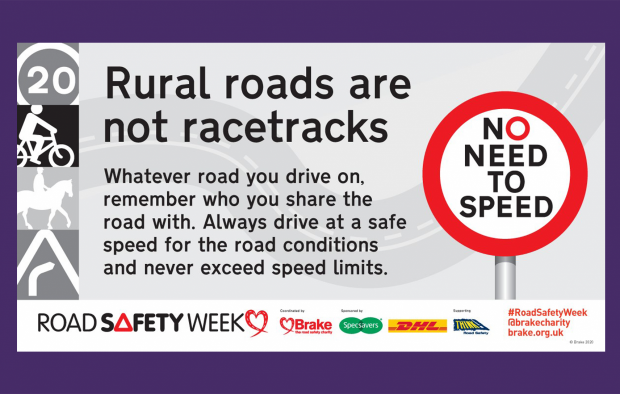
- Home
- News
- Road Traffic
- Road Safety Week: Rural Roads

Road Safety Week: Rural Roads
The majority of road deaths occur on rural roads, according to road safety charity Brake.
It is a major focus as part of Road Safety Week, with high speeds, narrow roads, blind bends and brows making for potentially dangerous driving conditions.
With limited safe places to pass, and few cycle routes or pavements, rural roads are the most dangerous roads for all kinds of road user per mile travelled. And that’s not the only worrying statistic. Here are the facts and figures from Brake:
- Ten times as many people die on rural roads than on motorways.
- Cyclists, motorcyclists and car drivers are more than three times as likely to be killed per mile travelled on a rural road than an urban road.
- Speed is often a major factor in rural road crashes. A study of single-carriageway rural roads estimated that a 10% increase in average speed results in a 30% increase in fatal and serious crashes.
- The most common crash types on rural roads are collisions at intersections, head-on collisions and running off the road.
- Many rural roads have poor road surface conditions and limited or no crash protection (such as crash barriers either at the side or in the middle of the road).
- Traffic often includes vehicles travelling at a wide variety of speeds, including slow-moving farm vehicles. There may also be animals, spillages or tree branches in the carriageway.
It is no wonder, then, that 62% of people think it is too dangerous to cycle on rural roads.
Here are the key things to remember to keep your rural driving safe:
- You should always reduce your speed as you approach a bend. Remember the bend may hide a horse and rider, a slow-moving vehicle or another hazard.
- Despite the fact that rural roads in the UK often have a 60mph speed limit, it is rarely safe to drive on them at that speed due to the condition of the road, potentially vulnerable road users, limited visibility, and debris such as mud or leaves on the road surface; reduce your speed.
- Look ahead and use tree lines, telegraph poles and hedges to determine where the road is going.
- After heavy rainfall, if you have no option other than to drive through floodwater, do so at a slow pace and be prepared to reverse out, should it become too deep. Always check your brakes after driving through deep water and if floodwater reaches the lower level of the doors, do not attempt to drive until a mechanic has looked at it.
- Horses and their riders are also likely to be on rural roads. Spotting a fresh pile of manure should alert you to the possibility that horses are not far away, so slow down and be prepared to stop if necessary. If you need to pass a horse, stay at least a car’s width away and avoid sudden noises or movements.
- Brake and sound your horn rather than swerving to avoid an animal in the road. Slight damage to your car is better than a serious accident due to losing control of your vehicle.
- Be patient while farmers use the road to move livestock to and from fields, or travel on the road in slow-moving farm vehicles.
- Be aware of your surroundings, from church spires suggesting an upcoming village to increased road markings indicating potential hazards.
--------------------------
Find out more at: roadsafetyweek.org.uk
And follow Winns social media for daily updates during Road Safety Week:
Twitter Facebook Instagram LinkedIn
Share this article
Would you know what to do if you had a non-fault accident?
Existing Client?
Keep on top of your claim 24/7, 365 days a year with Touchpoint, accessible from any internet-enabled device.



